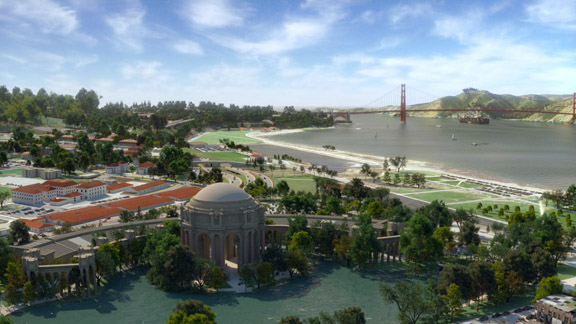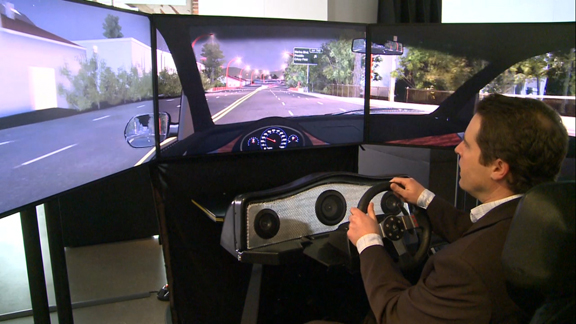March 16, 2011



In San Francisco, somewhere west of the Palace of Fine Arts, Doyle Drive looped through the Presidio’s sprawling green, catapulting you toward a breathtaking view of the San Francisco Bay and the Golden Gate Bridge. Originally built in 1936, the 1.5 mile corridor is now up for a face lift, mainly to redesign it so it can withstand the maximum credible earthquake in the region. The six-phase project, dubbed Presidio Parkway, involves constructions of twin tunnels, substations, and temporary bypasses. It began in early 2010, and is expected to run into early 2014. The completion is still years away, but this morning I had a chance to drive through the new Presidio Parkway, not as it is now but as it will be when it’s done.
To experience the new scenic route, you don’t have to go to the construction site (in fact, you shouldn’t, unless you’re a crew member). You can take a drive on the simulator, now installed at the Autodesk Gallery at One Market, San Francisco (open to the public every Wednesday from 12-5 PM).
The simulator is essentially a mechanical seat with folding display panels that imitate a windshield. Once you start the driving session, the 3D digital model of the route is loaded into the displays. The steering wheel, brake pedals, and gas pedals respond just as they would in a vehicle. The shifting perspective you see depicts what a driver would see when driving along the finished road, complete with simulated streetlamps and blue skies (you could even see a hint of the city’s ever-present blanket of fog).
The drive simulator is also an intersection where several different technologies and products merge. Part of the data used came from the city itself, which supplied high-res aerial photos and DWG files from the project. The design of the road itself—the curvature, turn, angle, placement, and others—was done using Autodesk Civil 3D software. The substation was designed in Autodesk Revit, a 3D architectural model package. All different data types were brought together in Autodesk NavisWorks, a software platform for visualizing integrated project models. To simulate the drive in real-time, Autodesk incorporated Unreal, a computer game engine, into the simulator’s setup. Just like in real life, the simulated drive-through obeys the laws of physics, as I discovered. When I accidentally drove into the guardrail, my virtual vehicle came to a stop.
Project managers and clients are also getting extra mileage out of the 3D drive-through exercise. The sequential development of the project, when simulated according to its planned time line, gave the design team an animation representing the order of construction. This gave them a chance to examine the workflow, plan road closures and equipment placement, and troubleshoot construction issues in advance. Fly-throughs of the new corridor and animation output from the drive simulator, all photo-realistically rendered in Autodesk 3ds Max, are now hosted at the project portal online, giving the public a chance to experience Presidio Parkway from the comfort of their own home.
Seasoned civil engineers from Parsons Brinkerhoff, the firm responsible for the project, can put on paper the layout of the new road without much difficulty. But the drive simulator provided them, the client, and the public with something engineers couldn’t deliver for all their technical expertise: a first-person point of view of Presidio Parkway in different driving conditions long before it is completed.
For more, watch the video report below (video footage and animation clips courtesy of Autodesk and Presidio Parkway project).
Subscribe to our FREE magazine, FREE email newsletters or both!
About the Author
Kenneth Wong is Digital Engineering’s resident blogger and senior editor. Email him at [email protected] or share your thoughts on this article at digitaleng.news/facebook.
Follow DE





